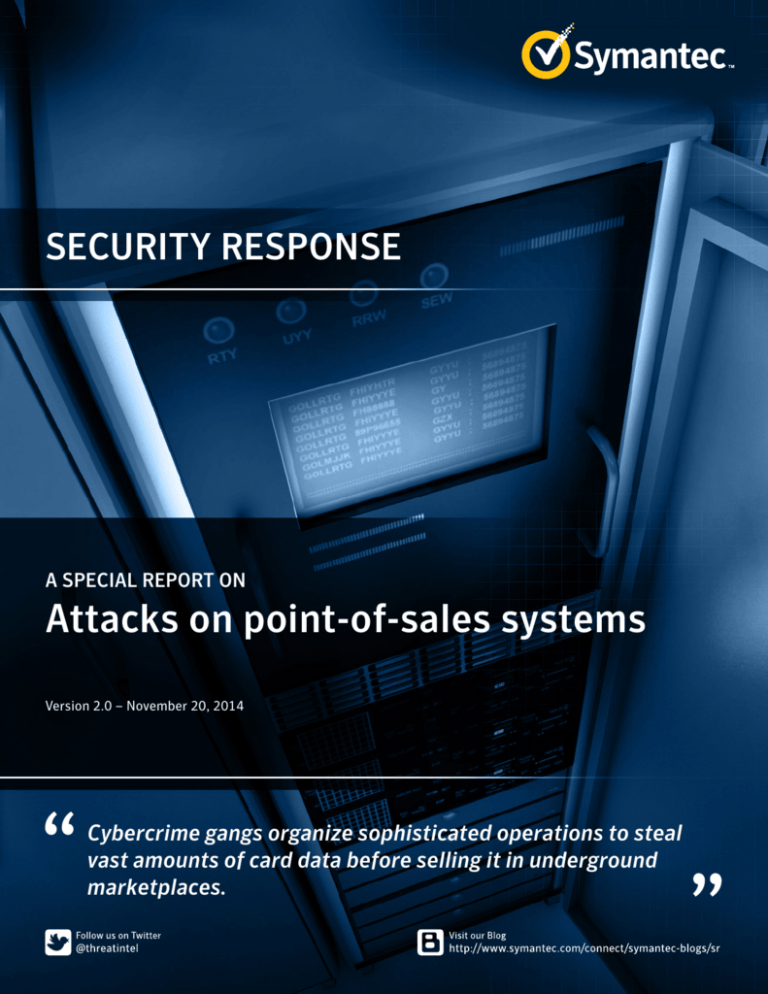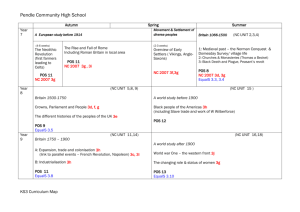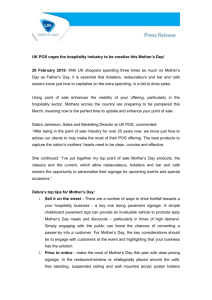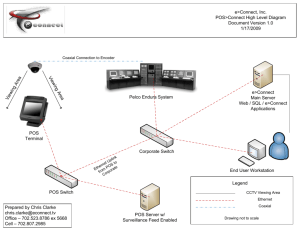
SECURITY RESPONSE
A SPECIAL REPORT ON
Attacks on point-of-sales systems
Version 2.0 – November 20, 2014
Cybercrime gangs organize sophisticated operations to steal
vast amounts of card data before selling it in underground
marketplaces.
CONTENTS
OVERVIEW...................................................................... 3
Background.................................................................... 5
Thriving marketplace for stolen cards..................... 5
Evolution of the threat............................................. 5
POS security issues........................................................ 6
Accessibility.............................................................. 6
Lack of point to point encryption (P2PE)���������������� 6
Software vulnerabilities........................................... 7
Susceptibility to malicious code............................... 7
Slow adoption of EMV ............................................. 8
Typical anatomy of attacks against POS systems
8
Infiltration................................................................ 8
Network traversal..................................................... 8
Data-stealing tools................................................... 9
Persistence and stealth............................................ 9
Exfiltration............................................................... 9
Protecting POS systems from attack........................... 11
Practical steps to take............................................ 12
Symantec protection.................................................... 13
OVERVIEW
Credit and debit card data theft is one of the earliest forms of cybercrime and persists
today. Cybercrime gangs organize sophisticated operations to steal vast amounts of data
before selling it in underground marketplaces. Criminals can use the data stolen from a
card’s magnetic strip to create clones. It’s a potentially lucrative business with individual
cards selling for up to US$130.
There are several routes attackers can take to steal this data. One option is to gain access
to a database where card data is stored. But another option is to target the point at which a
retailer first acquires that card data – the point-of-sale (POS) system.
Point-of-sale malware is now one of the biggest sources of stolen payment cards for
cybercriminals. Although it hit the headlines over the past year, the POS malware threat has
been slowly germinating since 2005. Attackers have honed their methods, paving the way
for the mega-breaches of 2013 and 2014, which compromised approximately 100 million
payment cards in the US.
The massive scale of attacks is explained in part because POS malware kits are now widely
available on the cybercrime underground. For a modest investment, attackers can buy tools
that can potentially net them millions.
Despite improvements in card security technologies and the requirements of the Payment
Card Industry Data Security Standard (PCI DSS), there are still gaps in the security of POS
systems. This coupled with more general security weaknesses in corporate IT infrastructure
means that retailers find themselves exposed to increasingly resourceful and organized
cybercriminal gangs.
Many US retailers are still vulnerable to point-of-sale malware attacks and are likely to
remain so until the complete transition to more secure payment card technologies in 2015.
BACKGROUND
Malware which is
purposely built to
steal data from
POS systems is
widely available in
the underground
marketplace.
SPECIAL REPORT: Attacks on point-of-sales systems
Background
Thriving marketplace for stolen cards
While the malware used to mount POS attacks is usually sold on underground forums, these forums are also
often where the bounty of those attacks returns to be sold. For example, stolen credit card details from some of
the biggest US breaches were sold on a forum known as Rescator.
Research from Symantec found that prices for payment card details can vary heavily depending on a number
of factors, such as the type of card and its level, i.e. gold, platinum, or business. Card data originating from the
US tends to be cheaper because of the widespread availability stolen US cards. Card details along with extra
information, known as “Fullz”, tend to attract higher prices because details such as someone’s date of birth or
credit card security password make it easier to perform identity theft.
Single credit cards from the US tend to cost $1.50 to $5, with discounts often available for those who buy in
bulk. Single cards from the EU tend to cost more, selling for $5 to $8. Fullz start at $5 and can range up to $20.
A single embossed plastic card with custom number and name meanwhile will sell for approximately $70. The
stolen cards uploaded to Rescator were initially selling at a cost of $45 to $130 per card before prices later
settled down.
Evolution of the threat
The term “POS device” most commonly
refers to the in-store systems where
customers pay merchants for goods or
services. While a lot of POS transactions
are carried out using cash, many of
these payments are made by customers
swiping their cards through a card
reader. These card readers may be
standalone devices but modern POS
systems, particularly those in larger
retailers, are all-in-one
systems which
can handle a
variety of customer
transactions such
as sales, returns, gift
cards and promotions.
Most importantly from a
security standpoint, they can
handle multiple payment types.
Attacks on point-of-sale terminals have their genesis as far back as 2005, when attackers began using
networking-sniffing malware to intercept payment card data while in transit. A group of attackers led by Albert
Gonzalez were the main perpetrators, sstealing more than 90 million card records from retailers.
As payments processors and retailers tightened up their security, the attackers adapted and attention turned to
the point-of-sale terminal. When a card is swiped, its details are briefly stored in the terminal’s memory while
being transmitted to the payment processor. This provides a brief window for malware on the terminal to copy
the card data, which it then transmits back to the attackers. The technique is known as “memory scraping” and it
is behind most of the major POS malware attacks seen in 2013 and 2014.
Page 5
SPECIAL REPORT: Attacks on point-of-sales systems
POS security issues
Many all-in-one POS systems are based on general purpose operating systems such as Windows Embedded,
Windows XP and later versions, and Unix operating systems including Linux. Consequently, these systems are
susceptible to a wide variety of attack scenarios which could lead to large scale data breaches.
Accessibility
All organizations that handle payment card data are required to implement safeguards set down in the PCI DSS.
This standard helps organizations to ensure that their systems and procedures are properly secured.
The standard describes a concept known as the cardholder data environment (CDE) and the need to protect
it. This is defined as “The people, processes and technology that store, process or transmit cardholder data or
sensitive authentication data, including any connected system components.”
The current standards recommend, but do not require the CDE to be network-segmented from other nonPOS systems and the public internet. While a strictly controlled and completely isolated POS system network
would be quite secure, it is too impractical for serious consideration. The POS systems must be accessible for
software updates and maintenance, allow business data to be exported to other systems (e.g. purchasing data
and inventory), allow system and security logs to be exported, have access to required support systems such as
network time protocol (NTP) servers (as required by the PCI DSS), and have connectivity to external payment
processors.
Despite lacking a rule for segmentation, the PCI DSS does mandate certain levels of access security. For example,
if remote access from a public network is allowed, the access must employ two-factor authentication (2FA).
In most mature retail environments, the CDE is appropriately segmented to reduce risk. However, in these
environments, pathways still exist from the general corporate network to the CDE.
While previous breaches have occurred by gaining direct access to POS systems, the most common attack route
against POS systems is through the corporate network. Once an attacker gains access to the corporate network,
for example through a vulnerable public-facing server or spear-phishing email, the attacker could traverse the
network until they gain access to an entry point to the POS network. This entry point is often the same as a
corporate administrator would utilize to maintain the POS systems.
Lack of point to point encryption (P2PE)
When an individual pays by swiping a credit card at a POS system, data contained in the card’s magnetic stripe
is read and then passed through a variety of systems and networks before reaching the retailer’s payment
processor. When this data is transmitted over a public network, the data must be protected using network level
encryption (e.g. Secure Sockets Layer (SSL)).
However, within internal networks and systems, the credit card number is not required to be encrypted except
when stored. Albert Gonzalez famously took advantage of this weakness in 2005 by infiltrating many retail
networks and installing network-sniffing tools, allowing him to gather over 100 million credit card numbers as
they passed through internal networks.
In response, many retailers today use network-level encryption even within their internal networks. While that
change protected the data as it travelled from one system to another, the credit card numbers are not encrypted
in the systems themselves and can still be found in plain text within the memory of the POS system and other
computer systems responsible for processing or passing on the data. This weakness has led to the emergence
of “RAM-scraping” malware, which allows attackers to extract this data from memory while the data is being
processed inside the terminal rather than when the data is travelling through the network.
Page 6
SPECIAL REPORT: Attacks on point-of-sales systems
Secure card readers (SCR) exist and have been implemented in some environments, enabling P2PE. This can
defeat RAM-scraping attacks that work by searching the memory of the POS system for patterns of digits that
match those of payment card numbers. Such card readers encrypt the card data at time of swipe and the credit
card number remains encrypted throughout the process even within the memory and underneath network-level
encryption.
Using P2PE within POS environments is not a new concept. Items such as PINs, when used with debit cards,
must be encrypted at the PIN pad terminal. When provisioning terminals, a payment processor or sponsor must
provision the terminal by performing “key injection” where a unique encryption key is deployed directly to the
device. With this scheme, the PIN remains encrypted at all times.
Software vulnerabilities
Many POS systems are running older operating systems, such as Windows XP or Windows XP Embedded. These
versions are more susceptible to vulnerabilities and are therefore more open to attack. It should also be noted
that support for Windows XP ended on April 8, 2014 but for Windows XP Embedded, the deadline has been
extended to January 12, 2016. No more patches will be issued for any vulnerabilities found in these operating
systems after the cutoff dates. This inevitably places POS operators under increased risk of a successful attack
and POS operators should have mitigation plans in place. Organizations should verify with Microsoft the exact
end-of-life date for the versions of Windows that they are using and plan accordingly.
Susceptibility to malicious code
As many POS systems are running a version of Windows, they are also capable of running any malware that
runs on Windows. This means that attackers do not need specialized skills in order to target POS systems and
malware that was not specifically designed for use on POS systems could be easily repurposed for use against
them.
POS malware was first discovered October 2008, when Visa issued an alert on a new type of exploit. During a
fraud investigation, it found that attackers had been installing debugging software on POS systems that was
capable of extracting full magnetic stripe data from its memory. Little heed appears to have been taken of this
warning, allowing malware authors time to perfect their methods. In the intervening period, the malware authors
have worked to streamline the malware, integrating all functionality into a single piece of software.
This development process eventually led to fully featured POS malware kits emerging on underground markets
from 2012 onwards. What followed was a flood of high profile breaches, with several major US hit by POS
malware attacks.
Case in point: BlackPOS
One of the most widely used forms of POS malware is BlackPOS (detected as Infostealer.Reedum), which is also
known as KAPTOXA, Memory Monitor, Dump Memory Grabber, and Reedum. Variants of BlackPOS have been
used to mount some of the biggest retail POS breaches.
Its development mirrors the evolution of the broader POS malware market. The earliest versions of BlackPOS
date from 2010. Over time, it has evolved into a highly capable cybercrime tool which employs encryption to
cover its tracks and can be customized to suit the target environment.
By February 2013, BlackPOS was ready for the mass market and the group behind one of its variants began
selling it on underground forums, charging customers $2,000 for the package.
Page 7
SPECIAL REPORT: Attacks on point-of-sales systems
Slow adoption of EMV
Europay, Mastercard and Visa (EMV) is a set
of standards for card payments. It is often
referred to as “chip and PIN” and is a
replacement for traditional magnetic
stripe-based cards. EMV
cards contain embedded
microprocessors
that provide strong
transaction security
features. EMV never transmits
the credit card data in the
clear, mitigating many common
POS attacks. EMV cards are also less
attractive to attackers as they are difficult
to clone.
While EMV is commonly used in some parts of the world such as Europe, US merchants in particular have been
slow to adopt the EMV standard and will not start implementing it until 2015.
Typical anatomy of attacks against POS systems
Attacks against POS systems in mature environments are typically multi-staged. First, the attacker must gain
access to the victim’s network. Usually, they gain access to an associated network and not directly to the CDE.
They must then traverse the network, ultimately gaining access to the POS systems. Next, they will install
malware in order to steal data from the compromised systems. As the POS system is unlikely to have external
network access, the stolen data is then typically sent to an internal staging server and ultimately exfiltrated from
the retailer’s network to the attacker.
Infiltration
There are a variety of methods an attacker can use to gain access to a corporate network. They can look for
weaknesses in external-facing systems, such as using an SQL injection on a web server or finding a periphery
device that still uses the default manufacturer password. Alternatively they can attack from within by sending
a spear-phishing email to an individual within the organization. The spear-phishing email could contain a
malicious attachment or a link to a website which installs a back door program onto the victim’s computer.
Network traversal
Once inside the network, the attackers need to gain access to their ultimate targets–the POS systems. Attackers
will typically use a variety of tools to map out the network in order to locate systems within the CDE. While they
may exploit vulnerabilities or use other techniques to gain access to these systems, often the simplest method
of gaining access is by obtaining user credentials. User credentials may be obtained through keylogging Trojans,
password-hash extraction, cracking, and/or replaying captured login sequences, or even brute force. Eventually,
the attackers may obtain administrative-level credentials. The attackers may even gain control of a domain
controller, giving them full access to all computers in the network. Once in control, they can then gain access
to the CDE even if it is in a segmented network by using network and data pathways established for existing
business purposes. Once inside the CDE, they can then install malware which allows them to steal card data
from the POS systems.
Page 8
SPECIAL REPORT: Attacks on point-of-sales systems
Data-stealing tools
Malware which is purposely built to steal data from POS systems is widely available in the underground
marketplace. In some attacks, network-sniffing tools are used to collect credit card numbers as they traversed
internal unencrypted networks. Other times, RAM-scraping malware is used to collect credit numbers as they are
read into computer memory. Any gathered data is then locally stored in a file until time for exfiltration. Often,
this data file needs to be transferred to multiple computers, hopping through the internal network until reaching
a system that has access to external systems.
Persistence and stealth
Because the attacker is targeting a POS system and these attacks take time to gather data, they need their code
to remain persistent on the compromised terminal. Unlike database breaches where millions of records are
immediately accessible, POS system breaches require the attacker to wait until transactions happen and then
collect the data in real-time as each credit card is used. Because of this, early discovery of the attack can limit
the extent of the damage. Malware persistence can be achieved using simple techniques to ensure that the
malware process is always running and restarts any time the system restarts.
Stealth techniques vary from simplistic obfuscation of filenames and processes to specific security softwarebypass techniques. In more secure environments, in order for attackers to succeed, they are already likely to
have access to compromised administrative credentials and can use them to scrub logs, disable monitoring
software and systems, and even modify security software configuration (e.g. change file-signing requirements or
modify whitelisting entries) to avoid detection.
Exfiltration
The attackers may hijack an internal system to act as their staging server. They will attempt to identify a server
that regularly communicates with the POS systems and piggyback on normal communications to avoid detection.
Any data collected by the RAM-scraping malware will be sent to this staging server, where it is stored and
aggregated until a suitable time to transmit to the attacker. At the appropriate time, the attackers may transfer
the gathered data through any number of other internal systems before finally arriving at an external system
such as a compromised FTP server belonging to a third party. By using compromised servers from legitimate
sites to receive the stolen data, the traffic to these sites is less likely to arouse suspicion on the part of the
compromised retailer, particularly if they are sites that are often visited by users within the victim organization.
Page 9
PROTECTING POS SYSTEMS
FROM ATTACK
There are many
steps that POS
operators can
take to reduce the
risk from attacks
against POS
systems.
SPECIAL REPORT: Attacks on point-of-sales systems
Protecting POS systems from attack
There are many steps that POS operators can take to reduce the risk of attacks against POS systems. The
following diagram illustrates the typical infrastructure of payment card systems and the threats against them,
along with mitigation strategies that can be employed at various points in the system.
Figure: Threat to payment card system and possible mitigation strategies
Page 11
SPECIAL REPORT: Attacks on point-of-sales systems
Practical steps to take
• Implementation of PCI DSS
• Install and maintain a firewall to facilitate network segmentation
• Change default system passwords and other security parameters
• Encrypt transmission of cardholder data across open, public networks
• Encrypt stored primary account number (PAN) and do not store sensitive authentication data
• Use and regularly update security software
• Use intrusion protection system (IPS) at critical points and the perimeter of the CDE
• Use file integrity and monitoring software
• Use strong authentication including two-factor authentication for remote systems
• Monitor all network and data access (SIEM)
• Test security systems, perform penetration testing, and implement a vulnerability management program
• Maintain security policies and implement regular training for all personnel
• Implement multi-layered protections including outside the CDE. Typically, the attacker needs to traverse
multiple networks and layers of security before reaching a POS system. Any single layer that the attacker is
unable to bypass prevents successful data exfiltration.
• Implement P2PE or EMV (“Chip and PIN”)
• Increase network segmentation and reduce pathways between the CDE and other networks.
• Maintain strict auditing on connections to between the CDE and other networks. Reduce the number of
personnel who have access to systems that have access to both the CDE and other networks.
• Employ two-factor authentication at all entry points to the CDE and for any personnel with access rights to the
CDE
• Employ two-factor authentication for all system configuration changes within the CDE environment
• Implement system integrity and monitoring software to leverage features such as system lockdown,
application control, or whitelisting
Page 12
SPECIAL REPORT: Attacks on point-of-sales systems
Symantec protection
Symantec products detect all of the currently known variants of point-of-sale malware, including:
BlackPOS
• Infostealer.Reedum
• Infostealer.Reedum!g2
• Infostealer.Reedum.B
• Infostealer.Reedum.C
FrameworkPOS
• Infostealer.Reedum.D
Dexter
• Infostealer.Dexter
Chewbacca
• Infostealer.Fysna
JackPOS
• Infostealer.Jackpos
RawPOS
• Infostealer.Rawpos
• Infostealer.Rawpos!g1
Vskimmer
• Infostealer.Vskim
Backoff
• Trojan.Backoff
• Trojan.Backoff!gm
Page 13
About Symantec
Symantec protects the world’s information and is the
global leader in security, backup, and availability solutions.
Our innovative products and services protect people and
information in any environment—from the smallest mobile
device to the enterprise data center to cloud-based systems.
Our industry-leading expertise in protecting data,
identities, and interactions gives our customers confidence
in a connected world. More information is available at
www.symantec.com or by connecting with Symantec at
go.symantec.com/socialmedia.
Headquartered in Mountain View, Calif.,
Symantec has operations in 40 countries.
More information is available at www.symantec.com.
For specific country offices and contact numbers, please visit our website.
Symantec World Headquarters
350 Ellis St.
Mountain View, CA 94043 USA
+1 (650) 527-8000
1 (800) 721-3934
www.symantec.com
Copyright © 2014 Symantec Corporation. All
rights reserved. Symantec, the Symantec Logo,
and the Checkmark Logo are trademarks or
registered trademarks of Symantec Corporation
or its affiliates in the U.S. and other countries.
Other names may be trademarks of their
respective owners.
Any technical information that is made available by Symantec Corporation is the copyrighted work of Symantec Corporation and is owned by Symantec
Corporation.
NO WARRANTY . The technical information is being delivered to you as is and Symantec Corporation makes no warranty as to its accuracy or use. Any use
of the technical documentation or the information contained herein is at the risk of the user. Documentation may include technical or other inaccuracies or
typographical errors. Symantec reserves the right to make changes without prior notice.






